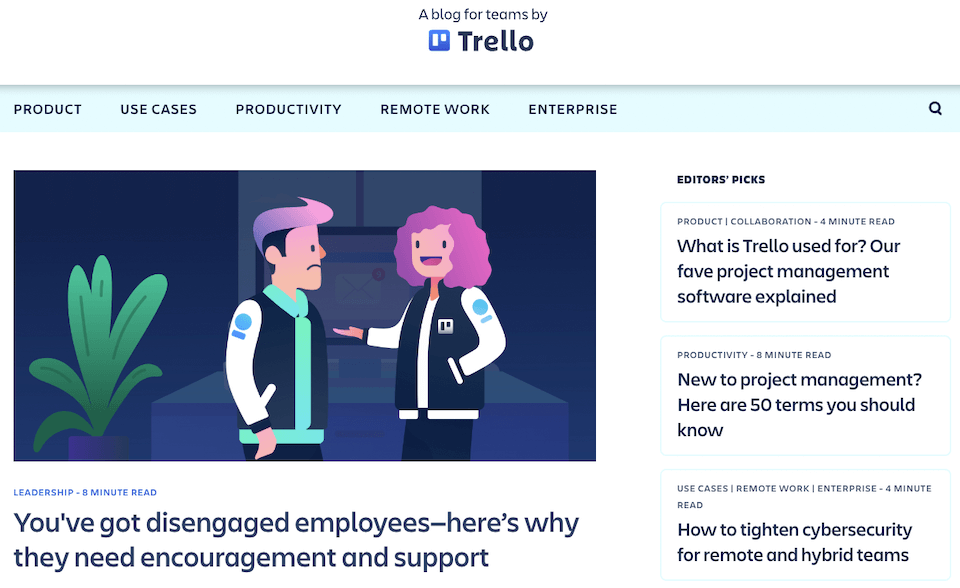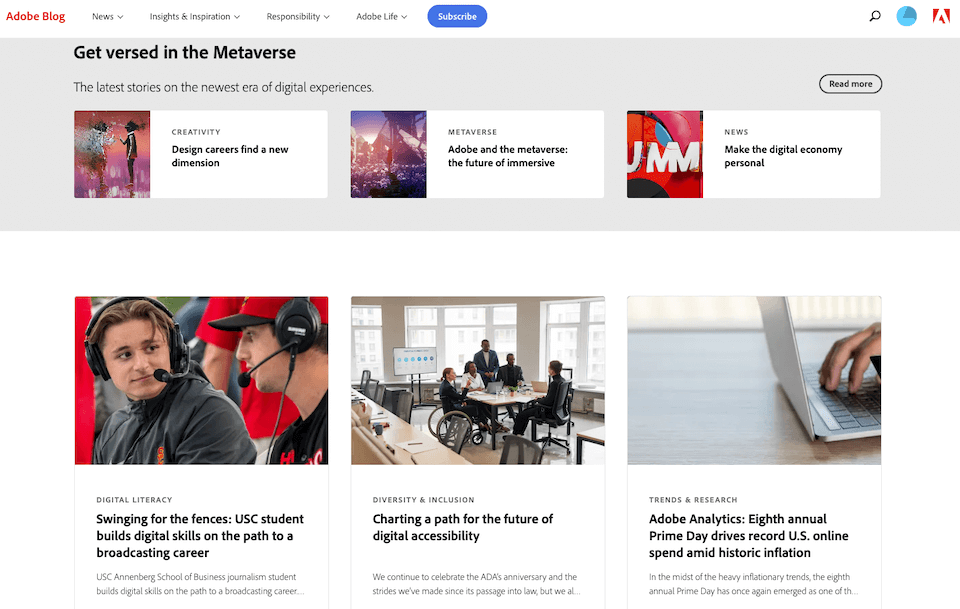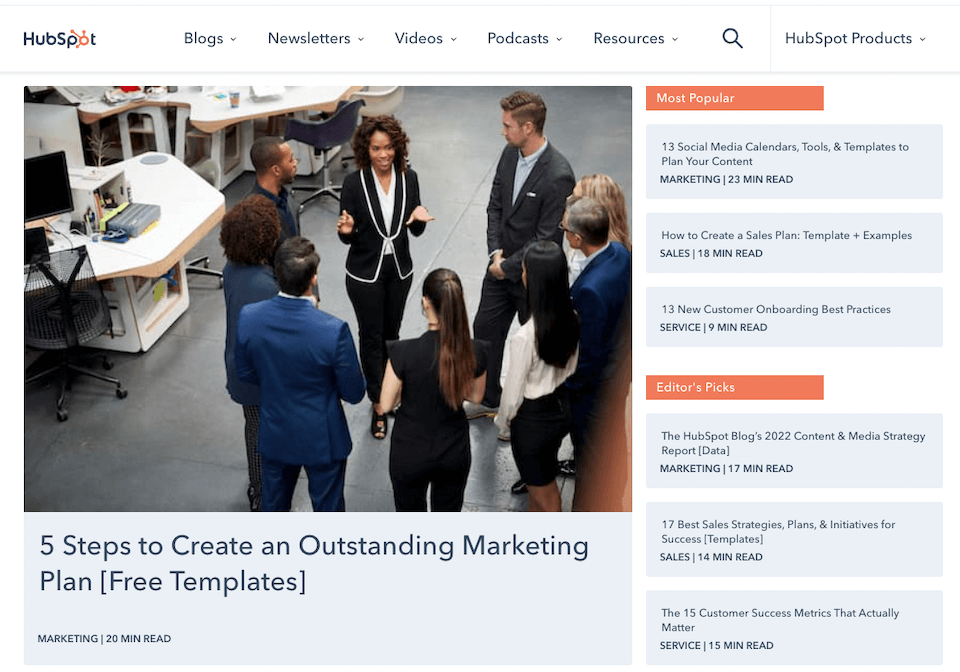
Strategic B2B Content Marketing: How-to Guide for 2024
Jul 26, 2022|Read time: 11 min.
Key Points
- 55% of B2B marketers changed their content marketing strategy in the last 2 years.
- B2B content marketing must engage multiple buyers at different stages of the funnel.
- The most effective content marketing for B2B companies targets the entire buyer’s journey.
If you lead a content marketing team at an enterprise B2B company, then you know how hard it is to connect with B2B buyers. Purchasing decisions can take months, and they often involve multiple decision makers who enter the sales funnel at different stages with different goals and concerns. To reach them all, you need an exceptional B2B content marketing strategy.
Furthermore, if you’re still using the same playbook as you were before the pandemic, it’s time for a strategic refresh! According to the Content Marketing Institute (CMI), 55% of B2B marketers changed their content marketing strategy in the last 2 years.
0
%of B2B marketers changed their content marketing strategy in the last 2 years
–Content Marketing InstituteMany of them shifted budget they saved from live events into content marketing, and discovered how effective this strategy is for reaching customers.
What is B2B content marketing
Marketing term
B2B Content Marketing
B2B content marketing is the process of using multiple types of content and channels to connect with potential customers at business-to-business brands. B2B content strategy involves multiple buyers at different stages of the sales funnel.
When it comes to content marketing, there’s a world of difference between B2B and B2C companies.
B2C vs B2B content marketing
The biggest difference between B2C and B2B content marketing is the end user. B2C content generally communicates to a single buyer. On the other hand, B2B content is created by businesses, for businesses, with a larger audience in mind.
That means your marketing success depends on reaching a more diverse audience with complex relationships. Decision makers at B2B businesses will consider high-level metrics like the product’s value to the organization. Further down the chain, department leaders will look at the more granular impact your solutions have on individual teams and employees.
It makes sense when you think about it. Bottom line cost savings won’t mean much if implementing the solution creates friction and frustration across teams.
The challenge of connecting with multiple buyers was confirmed in Content Marketing Institute’s 2022 annual report:
44% of B2B marketers say creating content for multi-level roles within the target audience is the most challenging aspect of their strategy.
— Content Marketing Institute
To reach each of these unique audiences, you’ll need to configure your messaging and content formats for specific buyer personas.
Key elements of a B2B content marketing plan
Before you develop a single piece of content, you need a plan to ensure everything you publish aligns with your business goals and your audience. The elements below are critical, but they’re just a small part of a comprehensive content strategy.
Create buyer personas for your target audience
Your marketing efforts won’t be effective unless you understand your target audience. You need to know who they trust, how they seek information, and what drives them to act. What are their pain points and motivators during the buyer’s journey?
In other words, you need several examples of buyer personas to guide your B2B content marketing. A buyer persona is defined as a fictional representation of your ideal audience. They reveal crucial details about customer segments so you can create great content that resonates with each group.
Personas help you to focus on the things that matter most to decision makers so your marketing efforts are more efficient and effective.
Develop customer journey maps
Knowing what potential customers want is just half the battle. You also need to understand how their needs change as they move through the sales funnel. To reveal critical moments of impact, develop customer journey maps for your most important audience members.
If you operate a marketing SaaS company, then define the business problems your solution solves for CMOs. Then, identify the other members of the buyer’s table who will seek answers to their problems. What questions will they ask, and who will they consult?
Your journey maps should clarify each step you want your audience to take. They should also highlight friction points as well as opportunities to move them deeper into the conversion funnel.
Choose your content distribution channels
As you create new content, whether to build brand awareness at the top of the content marketing funnel or to close the deal at the bottom, you must consider which channels to leverage.
Some content is better suited for your website or blog, while other formats work best as bylines or social media posts. Think about the marketing message you want to convey, who you want to reach, and what will resonate best with that segment.
These digital marketing channels are well-suited to B2B content marketing
- Your own website and blog
- Niche industry blogs
- Large media publications
- Social media platforms
- Webinars, and podcast platforms
- Email marketing
- PPC
- Affiliate or influencer marketing
Leverage marketing automation
Most folks assume small businesses struggle with content marketing, but enterprise brands have massive teams to crank out hundreds of pieces of content each month. The truth is, even large companies have bandwidth issues.
Marketing automation is one way you can overcome those hurdles and do more with less.
Some key benefits of marketing automation include better data, more efficient campaigns, and stronger personalization.
One way you can deploy automation is through downloadable assets such as white papers and templates. After you create the asset, publish a lead generation landing page to capture contact information in exchange for the download. Then, add CTAs to this page throughout your website. Finally, deliver automated email campaigns to audience segments based on their interests.
When your campaigns are up and running, track conversions using Google Analytics to improve engagement and performance.
Full-funnel B2B content marketing strategies
B2B content is much more effective when you take a full-funnel approach to marketing. Your strategy should be deep and wide to connect with potential customers and box out the competition. Introduce pain points, educate your audience about solutions, help them narrow down their decision, and clarify your unique value.
1. Integrate PR and bylines with B2B content marketing efforts
If you know the digital watering holes where your B2B buyers congregate, then publish thought leadership articles on those websites. These pieces of content will amplify brand awareness and introduce potential problems your audience should address.
In addition to bylines, your public relations efforts could earn valuable brand mentions on top-tier media outlets. These often come with backlinks that amplify trust and authority signals to help your website rank better in Google Search.
2. Design infographics
Great content doesn’t need to be complicated. Infographics are an excellent way to diversify your B2B content marketing efforts to connect with visual learners. Use them to show off your own proprietary data, or illustrate trends and insights within your industry.
Infographics don’t need to be massive to be effective, either. You can also create bite-size images that highlight a single data point or content idea.
The Brand Intelligence Report
Exclusive AI insights, search trends, and brand strategies, delivered to your inbox.
3. Publish blog posts + guides
Depending on how complex your industry or product is, you’ll probably need to educate your audience. One of the best ways to do that is with long-form content such as blog posts and guides.
These content formats are an excellent way to clarify confusing topics. You can walk readers through steps, methods, and examples, as well as guide them to your solution.
As an added benefit, high-quality content creation can drive valuable organic traffic to your website if you leverage search engine optimization (SEO) best practices.
4. Run retargeting ads
Retargeting ads give you the ability to reach customers who viewed your content but didn’t convert.
These ads can serve discount codes to users who abandoned a cart to convince them to complete the sale. You can also use retargeting to promote gated content based on the pages a user viewed on your website.
Retargeting is an excellent B2B content marketing tactic that falls in the middle of the funnel (MOFU).
5. Use video and webinars for B2B content marketing
Relationships are critical to the B2B sales process, and video is an excellent way to build them. Webinars allow you to showcase your expertise, forge strategic partnerships within the industry, and connect more personally with your audience.
0
%of B2B marketers plan to invest in videos in 2022
–Content Marketing InstituteThink beyond webinars and publish YouTube video content for users to discover. Then, you can embed this content into your educational blog posts to send users to your YouTube channel. Similar to blog posts, Google ranks video content in its organic search results which gives you more opportunities to reach your audience.
6. Leverage podcasts
On the spectrum of B2B content marketing, podcasts fall between public relations, thought leadership, and webinars. They grant you access to a larger audience while building trust and familiarity. They’re also excellent relationship-building tools.
Unlike webinars, podcasts engage audiences that prefer audio content which opens you up to a new channel. Furthermore, users can listen to audio content while traveling and doing other tasks.
There are two ways to leverage podcasts in your marketing strategy. Sign up to be a guest, or host your own and interview thought leaders. Obviously, hosting a podcast will require much more infrastructure than being a guest.
7. Create gated content
Gated content is a pillar of B2B content marketing because it allows you to provide exceptional value to your audience while demonstrating expertise.
Some common examples of gated content include white papers, templates, and market reports. This type of content marketing works at multiple stages of the buyer’s journey. It can be informational, strategic, or even sales oriented.
More importantly, asking for contact information supports your lead generation efforts by growing your email list.
8. Develop an email marketing strategy
Email marketing is a versatile tactic to include in your B2B content marketing toolbox. You can leverage software to create fully automated and highly targeted email marketing campaigns. Or you can send out an email blast to your entire subscriber list at once.
Email allows you to connect directly with your audience more efficiently. It also enables seamless personalization to boost engagement.
Think beyond company newsletters when you create content for emails. Instead, provide unique industry insights, stories, and value that drives your audience to subscribe and remain engaged with your emails.
9. Integrate social media into your B2B content marketing efforts
Some social media platforms are more effective than others for B2B content marketing. For example, you might not find value in TikTok, but LinkedIn is probably a powerful network. Each industry is different, so when you plan your social media strategy, research where your audience spends time.
Social media is an excellent channel for discovery, and it’s also a great place to diversify your content formats. Use images, videos, statistics, and quotes, and ask questions to keep your audience engaged.
Integrate your social media marketing efforts with your broader strategy, too. Repurpose the best B2B content ideas from your blog, share thought leadership articles you write on industry blogs, and promote your white papers and case studies.
10. Publish case studies
Further down the funnel, decision makers are narrowing down their options and looking for dependability and experience. That’s why case studies are a crucial component of a holistic B2B content marketing strategy.
Showcase your best results, and emphasize data points your target audience cares about most. Address the highest priority pain points they feel, and clearly articulate your unique value proposition.
11. Ask for testimonials & online reviews
While case studies provide the quantitative data, testimonials offer qualitative experiences. They demonstrate a level of trust that goes beyond results. Testimonials are about humanizing your brand and showing that you go above and beyond the competition.
On the other hand, online reviews offer a glimpse into what it’s like to work with your company. When your customers line up to put their stamp of approval on your business, those recommendations go a long way to creating social proof.
Exceptional B2B content marketing examples
The best way to develop a strategy for your own website is to draw inspiration from other brands. Here are three content marketing examples from top B2B companies.
Trello’s blog

Trello creates productivity and workflow-focused content which allows them to demonstrate their brand’s expertise and authority. But the company also understands that humans use their tool, so they maintain a friendly, relatable tone with colorful imagery and occasional goofiness.
The results look a lot like B2C content, and that’s by design. People who work at businesses are, after all, still consumers.
Adobe’s blog

It’s no surprise Adobe has a gorgeous blog. The company is chock full of design experts, so it feels like a magazine produced by and for creatives.
Although they’re sitting on a mountain of How-To topics, Adobe goes above and beyond educational content.
Through interviews with community players, free graphics, and general-interest articles about creative workplace dynamics and new technology, Adobe established themselves as a leading resource not just for people who use Adobe products, but for the entire creative community. Their authority is palpable, and that’s helpful when it’s time for designers to convince their bosses to buy the team Creative Cloud licenses.
HubSpot’s plethora of resources

HubSpot sells a full stack of software for marketing, sales, and customer service. If you’re in the marketing world, then you’ve definitely heard of them whether or not you use their suite of tools. They create comprehensive guides, helpful free tools, free marketing courses, research reports, a popular blog, and more.
HubSpot has thousands of in-depth articles about sales, marketing and customer support topics. But they don’t just publish content willy nilly. The Hubspot marketing team does extensive keyword research and meticulously optimizes its content.
As a result, they rank on Google page one for millions of marketing-related queries. Like Adobe, wielding that kind of natural exposure gives them a serious edge when it’s time for businesses to choose a marketing automation or CRM or customer service tool.




